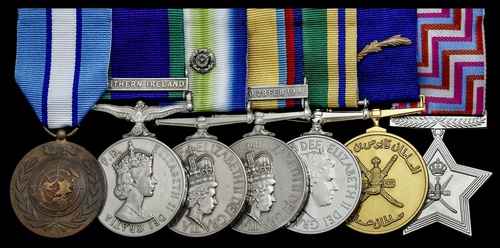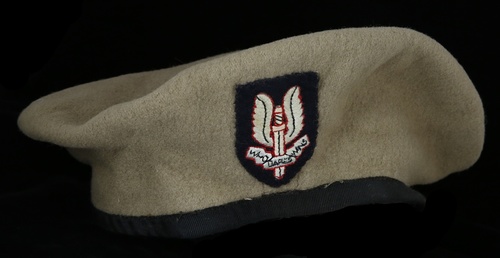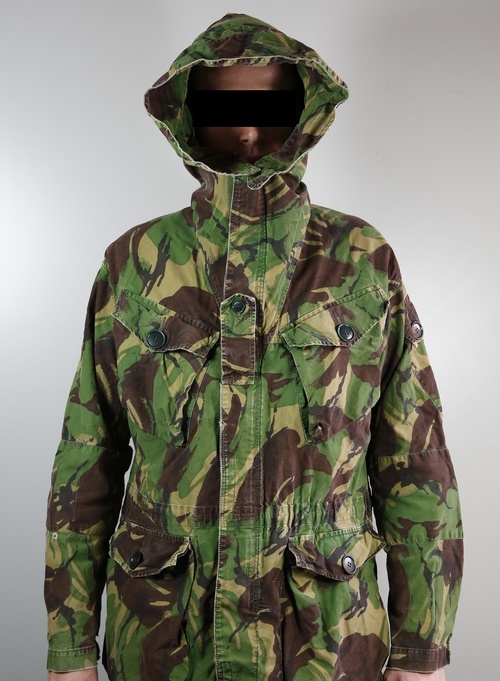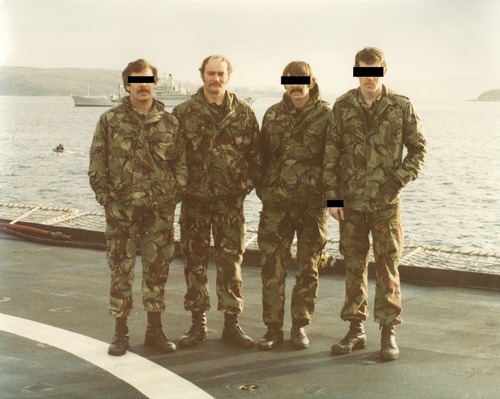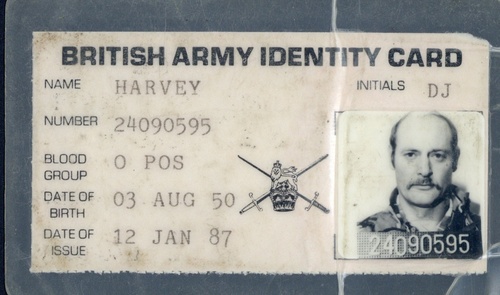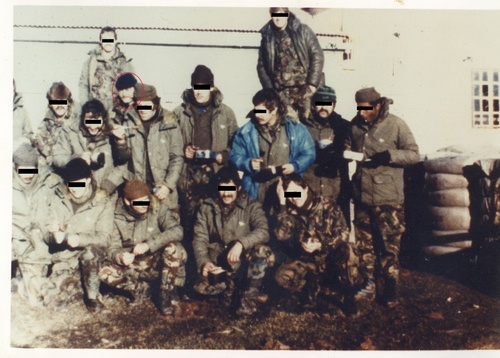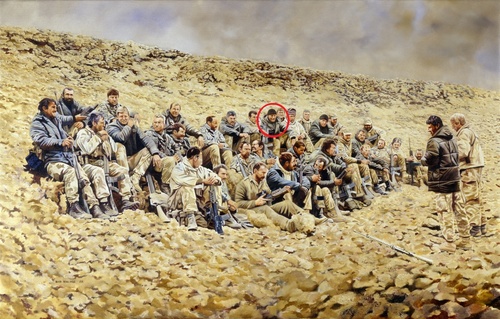Auction: 17002 - Orders, Decorations and Medals
Lot: 358
Sold by Order of the Recipient
An important - and unique - Special Forces group of seven awarded to Warrant Officer Class 1 D. J. 'Dia' Harvey, Special Air Service (S.A.S.) Regiment, late Royal Hampshire Regiment
As part of Operation "Corporate" he was deployed behind enemy lines in the Falklands with G Squadron, S.A.S., some three weeks before the main landings: in that period, as part of a four-man patrol, he undertook valuable - and gallant - surveillance work, prior to participating in fighting patrols, among them a selfless diversionary attack under heavy mortar fire at Port Stanley
Already a veteran of four tours in Northern Ireland in the Hampshires, Harvey returned to the troubled province with the S.A.S. and was instrumental is setting up a unique 'Under Cover Group': its purpose was to combine surveillance operations with follow-up 'Black Op. deletions'
He once more found himself operating behind enemy lines in the First Gulf War 1990-91 and, having lent telling service as an S.A.S. Forward Air Controller, he journeyed over the border in an armoured column to replenish SCUD-hunting teams such as "Bravo Two Zero": he also attended the memorable behind the lines 'Wadi Tubal Sergeants' Mess Meeting', where such pressing issues as carpeting and furniture at Regimental H.Q., Hereford were high on the agenda
S.A.S. expertise being much in demand, Harvey next oversaw the training of Counter Terrorist Units in the Sultan of Oman's Special Forces, prior to 'close protection work' in the Middle East: by one of those strange quirks of fate known to those operating in such hostile environments, he was lucky indeed to survive the suicide bombing of the Canal Hotel at Baghdad in August 2003
U.N. Medal, for Cyprus, unnamed as issued; General Service 1962-2007, 1 clasp, Northern Ireland (24090595 Pte. D. Harvey R. Hants); South Atlantic 1982, with rosette (24090595 Cpl D J Harvey R Hamps (SAS)); Gulf 1990-91, clasp 16 Jan to 28 Feb 1991 (24090595 S Sgt D J Harvey SAS); Iraq Reconstruction Service Medal 2003 (David Harvey); Oman, Sultanate, Sultan's Commendation Medal, with palm emblem on riband, unnamed as issued; Oman, Sultanate, 25th Anniversary Medal 1995, unnamed as issued, mounted court-style as worn, light contact marks, good very fine (7)
David John Harvey - known to his family and comrades as 'Dia' - was born in Southampton on 3 August 1950 and, on leaving school aged 14, worked in construction.
He subsequently joined the Junior Tradesmen's Regiment, before enlisting in the Royal Hampshire Regiment in April 1966, and went on to witness active service in Cyprus and Northern Ireland: he completed four operational tours in the troubled province, including a two-year posting to Ballykelly. Having then been advanced to Warrant Officer Class 1, Dia won selection for the Special Air Service (S.A.S.) in August 1981.
The Falklands
With the advent of hostilities in the South Atlantic, his first S.A.S. deployment quickly followed: as a member of a four-man patrol from G Squadron, and some three weeks before the main landings, he was inserted behind the lines - at night - by helicopter from H.M.S. Hermes.
Each man was laden with a 130lbs. pack, bulging with arms and ammunition, and their self-sufficient - unsupported - patrol work comprised covert surveillance. As one patrol member concluded, 'If all went wrong we weren't going to carry all that kit over 20 miles just to surrender': it would have been a firefight to the death.
By way of summary, the citation for Dia's Patrol Commander's subsequent award of the M.M. is quoted:
'Inserted by helicopter from the Naval Task Force at a distance of 120 miles from the islands, he maintained observations of enemy movement and dispositions in the Bluff Cove, West Stanley areas for a period of 28 days. In a totally hostile environment, with the only protection from the ground and air search provided by the stealth of his patrol, the reporting was both accurate and timely.
In order to obtain the detail of the enemy disposition, he was required to move his observation position to close and obvious positions to gain the intelligence required. This he did with great courage and skill knowing that if compromised his patrol could not have been extracted from any predicament caused by enemy action. In addition, he communicated his information in an environment where the enemy were known to possess Direction Finding capability'.
Due to that Direction Finding capability, Dia's patrol had to move back and forth through enemy lines, under cover of darkness, in order to send their reports through at differing locations and via short burst communications. They then had to return to their Observation Post before dawn, being careful to follow memorised routes to avoid land mines.
Following the success of this early deployment, Dia was employed in fighting patrols for the remainder of the conflict. On one occasion, a planned 'D' Squadron visitation to a fuel storage site in Port Stanley was quickly exposed to the local Argentine defences. Dia was with one of three G Squadron troops positioned on high ground overlooking the harbour. He takes up the story:
'They were unfortunately spotted by a searchlight from a hospital ship in the harbour. All hell broke loose and they had to abort the mission. We of G Squadron gave covering fire for their withdrawal and in doing so our positions were compromised and accurate mortar fire which must have been 'recorded' beforehand rained down all around. We took cover and made our escape back up a re-entrance after a short bout, only to find the mortars opened-up again, bracketing our route by estimating our speed and direction. Fortunately for us the ground was boggy due to constant rain and this mummified the bombs impact on detonation. After some nerve-racking minutes we reached an area where we could deviate out of the re-entrance and make for the E.R.V. If conditions had been dry, undoubtedly heavy casualties would have been incurred.'
Northern Ireland
In Dia's own words:
'Northern Ireland was no stranger to me, having served there with my parent regiment for four tours before joining the S.A.S., one of which was a two-year tour in Ballykelly. Several deployments later, while serving in the S.A.S. across the water, I was instrumental in setting up a unique 'Under Cover Group', based not only on surveillance operations but also on their follow-up, whereby many of the major terrorist players were deleted. This Group differed to the norm by being directly commanded by Knock R.U.C. H.Q., plus being operated Province-wide and alleviating the local S.A.S. Troop which was constantly over committed.'
The 'Group' comprised experienced soldiers of the S.A.S., second tour personnel from 14 Intelligence Company and men from the Special Boat Service: covert surveillance and 'deletions' were their prerogative.
Dia was invariably involved in related operations, most notably a 'lured attack' in August 1988, when one of the Group's number - an undercover S.A.S. Trooper - acted as the 'bait', playing the part of an off-duty soldier of Ulster Defence Regiment with a broken-down lorry on a road in County Tyrone. The local I.R.A. Active Service Unit took the bait, making haste to a known arms dump before approaching the undercover S.A.S. Trooper and opening fire with an AK47 from the window of their vehicle. The Trooper quickly took cover, allowing eight secreted S.A.S. men to drive home fire with G3s from a hedgerow and from a G.P.M.G. inside a derelict farm building: the terrorists were 'deleted'.
Desert Storm
With the impending commencement of the First Gulf War in late 1990, the initial outlook for S.A.S. operations in a climate of modern, high-tech warfare looked bleak: certain senior Allied commanders opined that laser-guided missiles delivered from the air were the way forward. However, General Sir Peter de la Billière - himself a former S.A.S. leader - undertook much canvassing in favour of the Regiment's deployment, and, as a result, 22 S.A.S. got the green light for uninhibited operations in the Southern Iraqi Desert.
Famously, the nature of that deployment was quickly amended by Saddam Hussein's use of his final long-range weapon, the Soviet-era ballistic SCUD missile: with their much-publicised deployment against Israel, it became a matter of urgency to hunt them - and their mobile carriers - down.
Scouting missions flown by aircraft bristling with modern technology having failed to locate a single carrier, 'A' and 'D' Squadrons, S.A.S. took up the baton: it was as part of this initiative that Dia acted as Forward Air Controller, guiding in strikes on the SCUD sites located by them.
Recommended viewing: https://www.youtube.com/watch?v=tEp5fCmTM5I
With mounting pressure, the S.A.S's reserve 'B' Squadron was also deployed, the story of one of its teams best known today as that of "Bravo Two Zero".
Following a period of two weeks operating behind enemy lines, the anti-SCUD patrols were in urgent need of re-supply. This resulted in the hasty formation of 'E' Squadron, in which Dia served. Equipped with six heavily-armed Series 60 Land Rovers, the Squadron escorted ten 4-tonne trucks across the border to a successful rendezvous at the Wadi Tubal. Here, then, at the behest of Regimental Sergeant-Major Peter Ratcliffe - and in typical S.A.S. fashion - a unique Sergeant's Mess meeting was convened on 16 January 1991: oblivious to their situation, the gathered throng discussed such pressing matters as the carpeting and furniture in the Regimental Mess at Hereford. The Minutes of the meeting having later been typed-up, they were signed by General Sir Peter de la Billière and General 'Stormin Norman' Schwarzkopf.
Ratcliffe went on to win the D.C.M. When he subsequently received his award from Her Majesty the Queen, she thoughtfully suggested to him that 'it must have been pretty terrible in the Gulf War': Ratcliffe - in mischievous S.A.S. style - responded, 'Actually, Your Majesty, I quite enjoyed it.'
For his own part, Dia received the Gulf Medal & clasp, his service record noting that he had in fact been deployed in the region on 'classified' activities from as early as December 1990.
He finally departed the S.A.S. on taking his discharge in July 1992, following 26 years with the Colours. As per his official Certificate of Service, he had attended numerous courses in the 'dark arts' and participated in 18 'Classified' operations within the United Kingdom - and four further 'Classified' operations elsewhere. His final assessment was written by Major-General J. T. 'Johnny' Holmes, D.S.O., O.B.E., M.C., who stated:
'Harvey has completed his service as a very experienced Warrant Officer. During his career in the Armed Forces, especially his eleven years in 22 Special Air Service Regiment, he has been deployed on a number of classified tasks throughout the world, all of which he carried out, with the utmost professionalism … with his positive attitude he will be successful at whatever task he decides to take on.'
Sultan's Special Forces
And so it proved, for on taking his discharge, Dia excelled as a Chief Instructor in the Counter Terrorism Unit of the Sultan of Oman's Special Forces. The newly formed unit specialised in the training and use of modern equipment and surveillance technology, including employment of American Hummer fighting vehicles. He also oversaw the implementation of technical planning and the use of field tactics and procedures.
He was awarded the Sultan's Commendation Medal and the 25th Anniversary Medal in 1995.
'Close Protection'
On departing the Sultan's Special Forces, Dia took up 'close protection' duties in the Middle East, working for British Petroleum and for the Foreign and Commonwealth Office and the Department for International Development; hence his Iraq Reconstruction Medal.
In a career marked by any number of 'close squeaks', his time in Iraq proved no different: he was on duty guarding a British diplomat at the time of the devastating suicide attack on the Canal Hotel at Baghdad on 19 August 2003. Dia takes up the story:
'Working in Iraq looking after Brit diplomats involved 6-man Close Protection Teams, each allocated to a diplomat and transported around in three armoured cars. On this particular occasion a U.N. meeting was being held in the Canal Hotel, Baghdad. Our client was attending this meeting, we having dropped him off first and then moved to the canteen for a brew. After an hour, a radio message came through that the meeting was finished. I told my crew to return to the vehicles, ready to escort our man back to the British Embassy. As we approached the main entrance from the canteen another message came through from our client saying he would be another 30 minutes before he was ready to leave. We returned through the building towards the canteen and within 30 seconds a truck laden with explosives crashed through the security fencing and exploded … fortunately our client was not hurt. The suicide truck driver, we later learned, had exploded the bomb next to our vehicles which were totally destroyed. For the sake of an extra brew we saved our lives. Incidentally, that bombing resulted in the withdrawal of the U.N. staff from Iraq.'
Postscript
'Who Dares Wins' is, of course, the famous motto of the S.A.S. but, as Dia has related with good humour to the cataloguer, sometimes that winning element proves out of reach. A keen sportsman throughout his military career, he once faced a rugby XV manned by monks from a local monastery: he and his S.A.S. colleagues were soundly thrashed.
Married to Carolyn, today Dia enjoys new challenges, among them pursuit of the wily brown trout with rod and fly.
Sold with the following original documentation and uniform:
(i)
The recipient's Certificate of Service and his British Army identity card, dated 12 January 1987.
(ii)
Field maps covering the Falklands and Iraq, as used on operations; together with silk evasion maps for Iraq and Oman.
(iii)
The camouflage smock and survival pack used by the recipient during his deployment in the Falklands.
(iv)
His beret with embroidered S.A.S. badge, and his stable belt.
(v)
Two prints relevant to the recipient's service in the S.A.S.
Reference Sources:
Ratcliffe, Major Peter, D.C.M., Eye of the Storm: Twenty-Five Years in Action with the S.A.S. (Michael O'Mara Books, 2003).
Lawrence, Richard Russell, The Mammoth Book of Special Ops.: The 40 Most Dangerous Special Operations of Modern Times (Mammoth Books, 2006).
Asher, Michael, The Real Bravo Two Zero (W. & N., 2003)
http://sasspecialairservice.com/
http://www.eliteukforces.info/special-air-service/history/desert-storm/
Subject to 20% VAT on Buyer’s Premium. For more information please view Terms and Conditions for Buyers.
Sold for
£23,000

